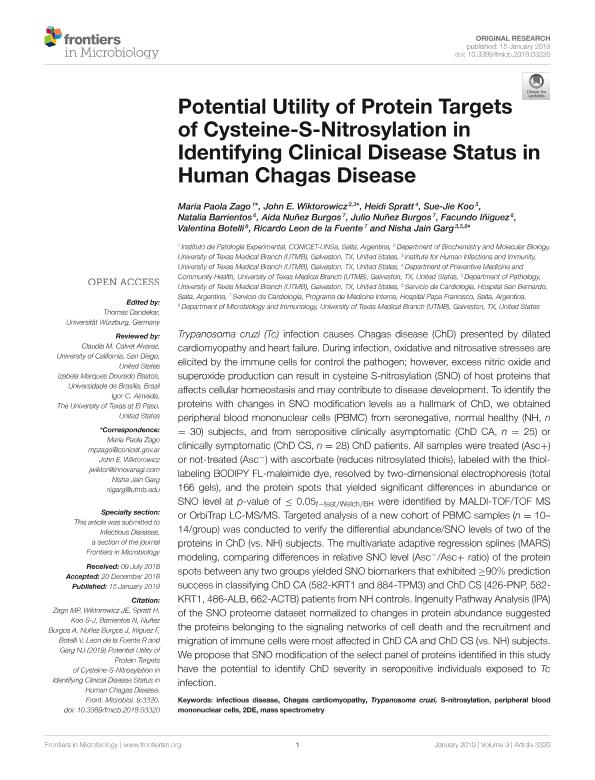Artículo
Potential utility of protein targets of cysteine-s-nitrosylation in identifying clinical disease status in human chagas disease
Zago, María Paola ; Wiktorowicz, John E.; Spratt, Heidi; Koo, Sue Jie; Barrientos, Natalia Mariel; Nuñez Burgos, Aida; Nuñez Burgos, Julio; Iñiguez, Facundo; Botelli, Valentina; Leon de la Fuente, Ricardo Alfonso
; Wiktorowicz, John E.; Spratt, Heidi; Koo, Sue Jie; Barrientos, Natalia Mariel; Nuñez Burgos, Aida; Nuñez Burgos, Julio; Iñiguez, Facundo; Botelli, Valentina; Leon de la Fuente, Ricardo Alfonso ; Garg, Nisha Jain
; Garg, Nisha Jain
 ; Wiktorowicz, John E.; Spratt, Heidi; Koo, Sue Jie; Barrientos, Natalia Mariel; Nuñez Burgos, Aida; Nuñez Burgos, Julio; Iñiguez, Facundo; Botelli, Valentina; Leon de la Fuente, Ricardo Alfonso
; Wiktorowicz, John E.; Spratt, Heidi; Koo, Sue Jie; Barrientos, Natalia Mariel; Nuñez Burgos, Aida; Nuñez Burgos, Julio; Iñiguez, Facundo; Botelli, Valentina; Leon de la Fuente, Ricardo Alfonso ; Garg, Nisha Jain
; Garg, Nisha Jain
Fecha de publicación:
01/2019
Editorial:
Frontiers Media S.A.
Revista:
Frontiers in Microbiology
e-ISSN:
1664-302X
Idioma:
Inglés
Tipo de recurso:
Artículo publicado
Clasificación temática:
Resumen
Trypanosoma cruzi (Tc) infection causes Chagas disease (ChD) presented by dilated cardiomyopathy and heart failure. During infection, oxidative and nitrosative stresses are elicited by the immune cells for control the pathogen; however, excess nitric oxide and superoxide production can result in cysteine S-nitrosylation (SNO) of host proteins that affects cellular homeostasis and may contribute to disease development. To identify the proteins with changes in SNO modification levels as a hallmark of ChD, we obtained peripheral blood mononuclear cells (PBMC) from seronegative, normal healthy (NH, n = 30) subjects, and from seropositive clinically asymptomatic (ChD CA, n = 25) or clinically symptomatic (ChD CS, n = 28) ChD patients. All samples were treated (Asc+) or not-treated (Asc−) with ascorbate (reduces nitrosylated thiols), labeled with the thiollabeling BODIPY FL-maleimide dye, resolved by two-dimensional electrophoresis (total 166 gels), and the protein spots that yielded significant differences in abundance or SNO level at p-value of ≤ 0.05t−test/Welch/BH were identified by MALDI-TOF/TOF MS or OrbiTrap LC-MS/MS. Targeted analysis of a new cohort of PBMC samples (n = 10– 14/group) was conducted to verify the differential abundance/SNO levels of two of the proteins in ChD (vs. NH) subjects. The multivariate adaptive regression splines (MARS) modeling, comparing differences in relative SNO level (Asc−/Asc+ ratio) of the protein spots between any two groups yielded SNO biomarkers that exhibited ≥90% prediction success in classifying ChD CA (582-KRT1 and 884-TPM3) and ChD CS (426-PNP, 582- KRT1, 486-ALB, 662-ACTB) patients from NH controls. Ingenuity Pathway Analysis (IPA) of the SNO proteome dataset normalized to changes in protein abundance suggested the proteins belonging to the signaling networks of cell death and the recruitment and migration of immune cells were most affected in ChD CA and ChD CS (vs. NH) subjects. We propose that SNO modification of the select panel of proteins identified in this study have the potential to identify ChD severity in seropositive individuals exposed to Tc infection.
Archivos asociados
Licencia
Identificadores
Colecciones
Articulos(IPE)
Articulos de INST.DE PATOLOGIA EXPERIMENTAL
Articulos de INST.DE PATOLOGIA EXPERIMENTAL
Citación
Zago, María Paola; Wiktorowicz, John E.; Spratt, Heidi; Koo, Sue Jie; Barrientos, Natalia Mariel; et al.; Potential utility of protein targets of cysteine-s-nitrosylation in identifying clinical disease status in human chagas disease; Frontiers Media S.A.; Frontiers in Microbiology; 9; 3320; 1-2019; 1-21
Compartir
Altmétricas



